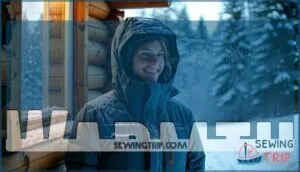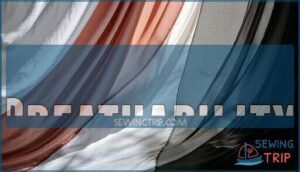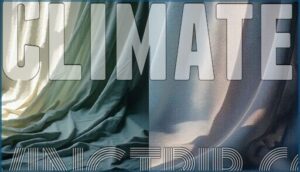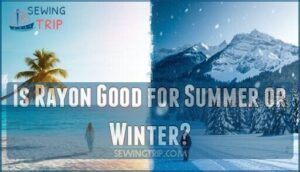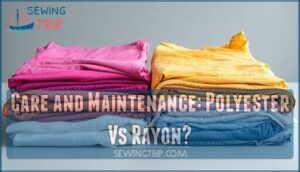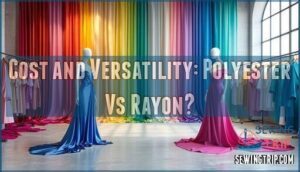This site is supported by our readers. We may earn a commission, at no cost to you, if you purchase through links.
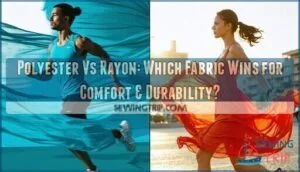 When comparing polyester vs rayon, you’re choosing between synthetic durability and natural comfort.
When comparing polyester vs rayon, you’re choosing between synthetic durability and natural comfort.
Polyester, made from petroleum-based chemicals, resists wrinkles, shrinking, and fading while lasting through countless washes.
It’s perfect for activewear and budget-conscious shoppers.
Rayon, derived from wood pulp, feels silky and breathable against your skin, making it ideal for hot weather and sensitive skin types.
However, rayon requires gentler care and can shrink or lose shape.
Polyester wins for low-maintenance durability, while rayon excels in comfort and moisture absorption.
The specific characteristics of each fabric reveal surprising advantages you might not expect.
Table Of Contents
Key Takeaways
- You’ll get better durability with polyester – it resists wrinkles, shrinking, and fading while lasting through countless washes, making it perfect for activewear and budget-conscious shopping.
- Rayon wins for comfort and breathability – its wood pulp construction feels silky against your skin and absorbs moisture effectively, making it ideal for hot weather and sensitive skin types.
- Polyester requires less maintenance – you can machine wash and tumble dry it without worry, while rayon needs gentle hand-washing and air-drying to prevent shrinkage and damage.
- Your climate should guide your choice – rayon excels in warm, humid conditions with superior airflow, while polyester works better in cold weather by trapping heat and providing insulation.
What is Rayon?
Rayon is a semi-synthetic fabric made from regenerated cellulose, typically sourced from wood pulp like bamboo or beechwood.
Unlike polyester’s fully synthetic petroleum base, rayon bridges natural and artificial fibers, offering a silk-like feel with better breathability but less durability.
Types of Rayon
You’ll discover five main types of rayon, each with unique properties.
Viscose rayon offers smooth texture and strong drape for affordable clothing. Modal provides enhanced wet-strength and softness, perfect for luxury items. Lyocell delivers eco-friendly production with excellent moisture-wicking capabilities.
One major concern is rayon’s environmental impact due to deforestation.
- Viscose rayon: Most common semisynthetic fiber with breathable qualities
- Modal properties: Superior strength and silky feel from beech trees
- Lyocell benefits: Closed-loop manufacturing reduces environmental impact
These rayon blends combine natural comfort with versatile performance across applications.
Difference Between Rayon and Polyester
Now that you understand rayon’s varieties, let’s examine what sets rayon apart from polyester.
These fabrics couldn’t be more different in their makeup and performance.
Key Differences Between Rayon and Polyester:
- Fabric Feel: Rayon offers a silky, luxurious touch while polyester feels stiffer and more synthetic
- Moisture Absorption: Rayon absorbs 11-14% of its weight in water; polyester absorbs less than 0.5%
- Tensile Strength: Polyester maintains strength when wet, but rayon loses up to 50% of its strength
- Dye Retention: Rayon accepts rich, deep colors easily while polyester requires special high-temperature dyeing
- Biodegradability: Rayon breaks down naturally while polyester persists in landfills for centuries
When comparing rayon vs polyester breathability, rayon wins hands down.
However, rayon vs polyester durability favors polyester’s wrinkle-resistant nature.
Your fabric choice depends on whether you prioritize comfort or longevity in your garments.
What is Polyester?
Polyester is a synthetic fabric made from petroleum-based chemicals, specifically designed to be durable, wrinkle-resistant, and easy to care for.
You’ll find this man-made fiber in everything from workout clothes to bedsheets because it holds its shape well and dries quickly.
Characteristics of Polyester
Polyester fabric offers impressive polyester strength and durability that’ll outlast many natural fibers.
You’ll appreciate its wrinkle resistance – no more ironing marathons after washing. The moisture wicking properties keep you dry during workouts, though fabric stiffness can make cheaper versions feel less comfortable.
The polyester properties include excellent colorfastness, meaning your colors won’t fade easily. The dyeing process creates vibrant hues that stay put.
While polyester advantages include low maintenance and longevity, polyester disadvantages involve reduced breathability compared to natural fibers.
When weighing polyester vs rayon durability, polyester wins hands-down for long-term wear.
Types of Polyester
Fabric enthusiasts encounter five main polyester types, each engineered for specific applications.
Understanding these variations helps you choose the right polyester fabric for your needs.
- PET Polyester (Polyethylene Terephthalate PET) – The workhorse accounting for 90% of production, offering excellent polyester properties
- PCDT – Higher elasticity than PET, perfect for upholstery requiring flexibility
- Microfiber Polyester – Ultra-fine fibers excelling in moisture management and stain resistance
- Recycled Polyester – Eco-friendly rPET maintaining original performance while reducing environmental impact
- Polyester Blends – Combines synthetic and natural fibers for enhanced comfort and durability
Polyester is known for its remarkable wrinkle resistance, making it a popular choice.
Rayon Vs Polyester: Comparison Table
Now you’ll understand exactly how these fabrics stack up against each other in key performance areas.
This side-by-side comparison helps you make the right choice for your specific needs, whether you’re shopping for summer clothes or durable workwear.
Warmth
When winter winds blow, you’ll appreciate polyester’s superior insulation properties over rayon fabric.
Polyester fabric traps warm air close to your body, maintaining body temperature even in cold weather conditions.
Its synthetic fibers create excellent heat retention, making it perfect for layering options in your winter wardrobe.
Many shoppers prioritize polyester’s warmth in winter for outdoor activities.
| Feature | Polyester | Rayon |
|---|---|---|
| Heat Retention | Excellent insulator | Poor thermal protection |
| Cold Weather Performance | Keeps you warm | Allows heat escape |
| Layering Effectiveness | Ideal base/mid layer | Better for warm climates |
Rayon’s moisture absorption and breathability work against warmth retention, while polyester vs rayon breathability shows polyester’s ability to insulate without sacrificing comfort during active wear.
Polyester is known for its ability to insulate and provide comfort during active wear.
Breathability
When warmth matters less than staying cool, breathability becomes your best friend.
Rayon fabric excels at moisture absorption and airflow, while polyester fabric traps heat and resists moisture.
Your activity level and climate factors determine which works better for you.
| Factor | Rayon Properties | Polyester Fabric |
|---|---|---|
| Moisture Absorption | Absorbs 11-14% of weight | Less than 0.5% absorption |
| Airflow | Open cellulose structure allows circulation | Synthetic fibers restrict ventilation |
| Skin Comfort | Cool, breathable feel | Can feel stuffy, traps sweat |
The weave impact matters too—loose rayon beats tightly-knit polyester every time.
For polyester vs rayon breathability, rayon wins hands down in hot weather, keeping you comfortable when temperatures rise.
You can find a variety of options for rayon breathable fabric online.
Climate
If you’re chasing cool comfort, rayon’s breathability and moisture absorption make it a winner for warm climates and sticky summers.
Polyester, on the other hand, shrugs off moisture, keeping you dry in colder weather.
Viscose, a type of rayon, offers similar comfort due to its silk-like texture.
Here’s a quick look:
| Fabric | Climate Suitability | Seasonal Comfort |
|---|---|---|
| Rayon | Warm climate | Cool, airy feel |
| Polyester | Cold climate | Dry, cozy warmth |
The key factors to consider are warm climates, moisture absorption, and the silk-like texture of viscose, which all contribute to the overall comfort of the fabric.
Durability
You’ll find that polyester fabric substantially outperforms rayon fabric in durability tests.
Polyester’s superior fiber strength and tear resistance make it the clear winner for long-term use, while rayon’s delicate fibers require gentle handling to prevent damage.
| Durability Factor | Polyester | Rayon |
|---|---|---|
| Tear Resistance | Excellent – withstands pulls and scrapes | Poor – tears easily with rough handling |
| Abrasion Resistance | High – maintains appearance after repeated use | Low – frays and pills with normal wear |
| Fiber Strength | Strong when wet or dry | Loses 50% strength when wet |
Polyester dominates in longevity comparison studies, lasting years longer than rayon in identical conditions.
Its resistance to tearing is a key factor, as shown in polyester product listings.
Even blend durability improves when polyester combines with other fibers, creating stronger fabrics overall.
Shrinking
Beyond durability concerns, shrinking behavior reveals another key difference between these fabrics.
Polyester resistance to shrinkage far exceeds rayon’s performance due to its synthetic polymer structure.
While rayon shrinkage can reach 20% with improper care, polyester fabric maintains its original size remarkably well.
| Fabric | Shrinkage Rate | Care Requirements |
|---|---|---|
| Rayon | 5-20% potential | Cold water, air dry |
| Polyester | Less than 5% | Standard washing acceptable |
| Rayon blend | 3-8% typical | Gentle care recommended |
| Polyester blend | 1-3% minimal | Easy maintenance |
Wash temperatures substantially impact rayon fabric’s stability, with hot water triggering substantial fiber contraction.
Drying methods matter too—machine drying can devastate rayon garments.
Blend stability improves when polyester joins rayon, reducing overall shrinkage rates while maintaining some breathability advantages.
Is Rayon Good for Summer or Winter?
You’ll want to keep in mind seasonal temperatures when choosing between rayon and polyester for your wardrobe.
Rayon’s breathable, moisture-absorbing properties make it perfect for hot summer days, while polyester’s insulating qualities work better in cooler weather.
Climate Suitability
Climate often determines your fabric choice between rayon and polyester.
For warm climate conditions, rayon delivers superior breathability and moisture absorption, keeping you comfortable during humid summer days. Its natural ventilation makes it perfect for high activity levels and seasonal comfort.
Conversely, polyester excels in cold climate situations by retaining body heat and providing essential layering options. While polyester lacks humidity performance, it maintains warmth when temperatures drop, making it ideal for winter wear and outdoor activities.
Rayon, however, isn’t ideal, as it lacks insulating air pockets, which is crucial for cold climate situations, and it fails to provide the necessary insulating properties for colder weather, highlighting the importance of choosing the right fabric for the right season.
Cost and Versatility
When examining price points and production costs, polyester consistently costs 30-40% less than rayon while offering superior versatility applications.
You’ll find polyester dominates market availability across all clothing categories year-round, whereas rayon’s seasonal limitations restrict its cost-effectiveness.
Blended fabrics combining both materials maximize your investment by balancing affordability with performance.
Should You Choose Polyester or Rayon?
Choosing between polyester and rayon depends on your specific needs and priorities.
You’ll want to take into account factors like climate preferences, maintenance requirements, and budget constraints to make the right decision for your wardrobe.
Climate Suitability: Polyester Vs Rayon?
Your fabric’s breathability determines seasonal comfort more than you might think.
Rayon excels in humid climates and warm weather due to superior moisture absorption, making it ideal for summer layering options.
Polyester suits cold climates better with quick-drying properties, though it traps heat during high activity levels, reducing breathability when you need airflow most.
Consider also how fabric weight and GSM impacts seasonal wear.
Care and Maintenance: Polyester Vs Rayon?
When comparing fabric maintenance, you’ll discover polyester wins the convenience game hands down.
Machine-washable polyester tolerates normal cycles and tumble-drying, while rayon demands gentle hand-washing and air-drying to prevent shrinkage.
Consider these care differences:
- Washing methods: Polyester handles standard detergents; rayon needs mild formulas
- Drying techniques: Polyester air-dries quickly; rayon requires flat positioning
- Ironing needs: Polyester rarely wrinkles; rayon demands careful steaming
Storage solutions favor polyester’s resilient structure over rayon’s delicate fibers.
Cost and Versatility: Polyester Vs Rayon?
Your wallet will thank you for choosing polyester over rayon.
Polyester costs roughly half as much per kilogram, making it the go-to fabric for budget-conscious shoppers and fast fashion brands.
However, rayon’s versatility shines in design applications, mimicking silk, cotton, and wool beautifully.
Blending options offer the best of both worlds—polyester’s affordability with rayon’s luxury feel for smart clothing investments.
Frequently Asked Questions (FAQs)
What Is Rayon?
Ever wondered what gives certain fabrics that silky, luxurious feel?
Rayon’s a semi-synthetic fiber made from regenerated cellulose, typically sourced from wood pulp.
It’s breathable, moisture-absorbent, and drapes beautifully, making it perfect for comfortable clothing.
What Is Polyester?
Polyester is a fully synthetic fiber made from petroleum-based polymers, specifically polyethylene terephthalate.
You’ll recognize its durable, wrinkle-resistant properties that make it perfect for sportswear and everyday clothing that needs minimal maintenance.
What Is The Difference Between Rayon And Polyester?
Like choosing between a horse-drawn carriage and a Model T, you’re picking between two distinct materials.
Rayon’s semi-synthetic, made from wood pulp, feels soft and breathable but wrinkles easily.
Polyester’s fully synthetic, petroleum-based, durable and wrinkle-resistant but less breathable.
Is rayon better than polyester for health?
Rayon breathes better and feels softer against your skin than polyester, making it gentler for sensitive skin. However, it’s not inherently "healthier" – both fabrics are generally safe to wear.
Can you blend rayon and polyester together?
Yes, you can absolutely blend rayon and polyester together!
This combination creates fabrics that balance rayon’s softness and breathability with polyester’s durability and wrinkle resistance, offering the best of both worlds.
Which fabric causes more skin allergies?
Synthetic fabrics like polyester typically trigger more skin allergies than semi-synthetic ones.
You’ll find polyester’s petroleum-based fibers can trap heat and moisture, creating irritation.
Rayon’s cellulose base breathes better, making it gentler on sensitive skin overall.
Do rayon clothes fade faster than polyester?
Color behaves differently across fibers.
You’ll notice rayon fades faster than polyester because its cellulose structure absorbs dyes deeply but releases them more easily during washing, while polyester’s synthetic fibers hold color longer.
Which fabric is better for athletic wear?
Polyester wins for athletic wear. It’s moisture-wicking, dries quickly, holds its shape, and won’t shrink or wrinkle. You’ll stay cooler and more comfortable during workouts.
Can you iron rayon and polyester safely?
You can iron both fabrics, but they need different approaches.
Use low heat for rayon since it’s delicate and can scorch easily.
Polyester handles medium heat well but may melt under high temperatures, making high temperatures a critical factor to consider.
Conclusion
Ultimately, which fabric should you choose for your wardrobe? The polyester vs rayon debate comes down to your priorities.
If you’re seeking low-maintenance durability and wrinkle resistance, polyester delivers unmatched performance for activewear and everyday garments.
However, if comfort and breathability matter most, rayon’s natural feel and moisture-wicking properties make it superior for warm weather clothing.
Consider your lifestyle, climate, and care preferences when deciding between these fabrics for maximum satisfaction.


